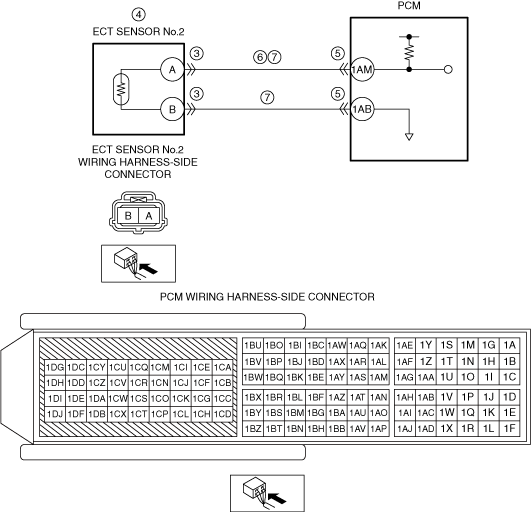|
1
|
RECORD VEHICLE STATUS AT TIME OF DTC DETECTION TO UTILIZE WITH REPEATABILITY VERIFICATION
-
Note
-
• Recording can be facilitated using the screen capture function of the PC.
• Record the FREEZE FRAME DATA/snapshot data on the repair order.
|
—
|
Go to the next step.
|
|
2
|
VERIFY RELATED SERVICE INFORMATION AVAILABILITY
• Verify related Service Information availability.
• Is any related Service Information available?
|
Yes
|
Perform repair or diagnosis according to the available Service Information.
• If the vehicle is not repaired, go to the next step.
|
|
No
|
Go to the next step.
|
|
3
|
INSPECT ECT SENSOR NO.2 CONNECTOR CONDITION
• Switch the ignition off.
• Disconnect the ECT sensor No.2 connector.
• Inspect for poor connection (such as damaged/pulled-out pins, corrosion).
• Is there any malfunction?
|
Yes
|
Repair or replace the connector and/or terminals, then go to Step 8.
|
|
No
|
Go to the next step.
|
|
4
|
DETERMINE IF ECT SENSOR NO.2 OR WIRING HARNESS MALFUNCTION
• Reconnect all disconnected connectors.
• Access the ECT2_V PID using the M-MDS.
• Verify the ECT2_V PID value when disconnecting the ECT sensor No.2 connector.
• Does the ECT2_V PID value change?
|
Yes
|
Replace the ECT sensor No.2, then go to Step 8.
|
|
No
|
Go to the next step.
|
|
5
|
INSPECT PCM CONNECTOR CONDITION
• Switch the ignition off.
• Disconnect the PCM connector.
• Inspect for poor connection (such as damaged/pulled-out pins, corrosion).
• Is there any malfunction?
|
Yes
|
Repair or replace the connector and/or terminals, then go to Step 8.
|
|
No
|
Go to the next step.
|
|
6
|
INSPECT ECT SENSOR NO.2 SIGNAL CIRCUIT FOR SHORT TO GROUND
• Verify that the PCM connector is disconnected.
• Disconnect the ECT sensor No.2 connector.
• Inspect for continuity between ECT sensor No.2 terminal A (wiring harness-side) and body ground.
• Is there continuity?
|
Yes
|
Refer to the wiring diagram and verify whether or not there is a common connector between ECT sensor No.2 terminal A and PCM terminal 1AM.
If there is a common connector:
• Determine the malfunctioning part by inspecting the common connector and the terminal for corrosion, damage, or pin disconnection, and the common wiring harness for a short to ground.
• Repair or replace the malfunctioning part.
If there is no common connector:
• Repair or replace the wiring harness which has a short to ground.
Go to Step 8.
|
|
No
|
Go to the next step.
|
|
7
|
INSPECT ECT SENSOR NO.2 SIGNAL CIRCUIT AND GROUND CIRCUIT FOR SHORT TO EACH OTHER
• Verify that the ECT sensor No.2 and PCM connectors are disconnected.
• Inspect for continuity between ECT sensor No.2 terminals A and B (wiring harness-side).
• Is there continuity?
|
Yes
|
Refer to the wiring diagram and verify whether or not there is a common connector between the following terminals:
• ECT sensor No.2 terminal A—PCM terminal 1AM
• ECT sensor No.2 terminal B—PCM terminal 1AB
If there is a common connector:
• Determine the malfunctioning part by inspecting the common connector and the terminal for corrosion, damage, or pin disconnection, and the common wiring harness for a short to each other.
• Repair or replace the malfunctioning part.
If there is no common connector:
• Repair or replace the wiring harness which has a short to each other.
Go to the next step.
|
|
No
|
Go to the next step.
|
|
8
|
VERIFY DTC TROUBLESHOOTING COMPLETED
• Always reconnect all disconnected connectors.
• Clear the DTC from the PCM memory using the M-MDS.
• Perform the KOEO or KOER self test.
• Is the same DTC present?
|
Yes
|
Repeat the inspection from Step 1.
• If the malfunction recurs, replace the PCM.
Go to the next step.
|
|
No
|
Go to the next step.
|
|
9
|
VERIFY AFTER REPAIR PROCEDURE
• Perform the “AFTER REPAIR PROCEDURE”.
• Are any DTCs present?
|
Yes
|
Go to the applicable DTC inspection.
|
|
No
|
DTC troubleshooting completed.
|
